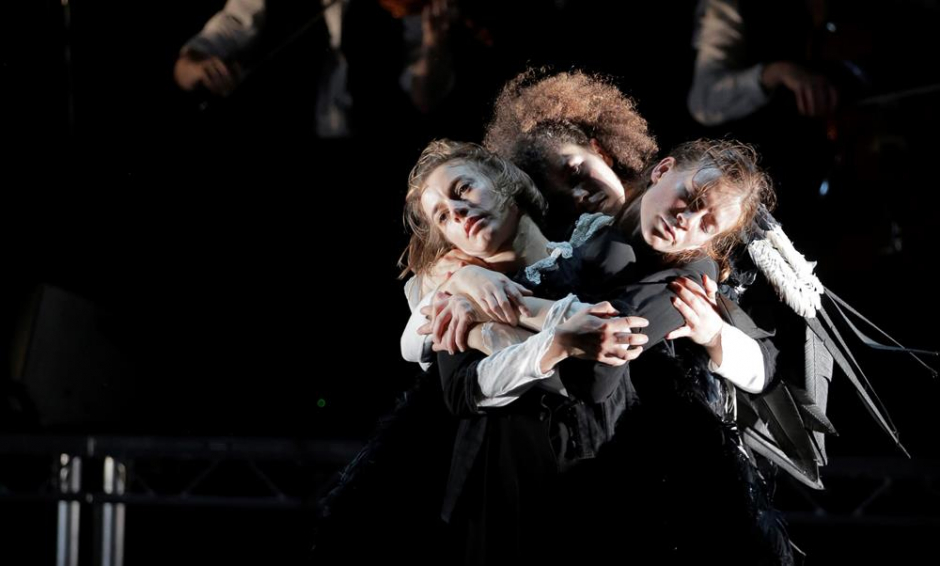Week 53 | The Lowry | Swan Lake / Loch na hEala | Michael Keegan-Dolan & Teac Damsa
Swan Lake / Loch na ehEala won the Irish Times Theatre Award in 2017, and came to the Lowry as part of the 12-day Week 53 ‘Festival for the Curious’. Michael Keegan-Dolan is considered a leader in the world of contemporary choreography, and he constructs scenes of such intimacy that I sometimes felt embarrassed to witness the collapse of a family. His reimagining of Swan Lake was as bleak as it was beautiful.
The opening scene of the play is perhaps one of the most symbolically rich. A half-naked Mikel Murfi – who plays a priest, a crooked cop, and a seedy politician – circles the post to which is fastened by the neck like a lamb. When he is “released” from his tether and forced into clothes by three suit-jacketed, finger-clicking dancers, the audience do not feel as if he has truly been freed at all. Instead, we feel as if he has been forced out of innocence. Murfi’s roles are at the heart of the performance, but the troupe of Teac Damsa dancers (playing, variously, as swans, Jimmy’s suitors and the agents of the state) are a brilliant foil to his crises.
Dealing with themes of police brutality, rural poverty, corruption, abuse of power within the clergy, depression and bereavement, on the surface there is not much to link this piece to the Russian ballet Swan Lake. Only when you look deeper do you see that this is just a new variation on the old theme. In the original ballet the evil sorcerer Von Rothbart is the force that transfigures Odette into a swan, but here it is a warped Catholic priest who sexually assaults the parallel character of Fionnula. Fionnula and her sisters are forbidden to tell anyone, on pain of “becoming filthy animals”. When they do try to report him, the covenant is upheld and they are doomed to fly.
All of this is set against a harsh, minimalist backdrop, with matte black scaffolding surrounding the proscenium that sinks back into the angular shadows it imitates. Very few details are depicted. Tea, biscuits, and cigarettes are the scant scene setters that mimic the wine, pheasant, and poultry of the original Swan Lake. By the end of the show, the air in the set is dense with feathers, like the exploded remnants of a brutal pillowfight.
The sharp contrast between the lush world of Prince Siegfried in the original, and the scraped existence of clinically depressed Jimmy in an ancient rural cottage is painfully poignant. The existence of small farm families like this all over rural Ireland is at once a pride of the country, since the idea of subsistence has altogether more glamour than the Scot tenancy model, and a detraction from a nation at the forefront of the digital revolution. One casualty of this development from a rural to a more cosmopolitan open society is Jimmy’s security, and his father’s house.
As well as Swan Lake, Loch na hEala draws on the complex folk tale of “The Children of Lir”, an Irish fable about children being turned into swans, and utilizes it to dazzling dramatic effect. Crying children, cursed to spend hundreds of years flying aimlessly around Ireland by their wicked stepmother, must be blessed by a monk in order to revert to human form. In this way, Loch na hEala is a portmanteau of the two stories, with the beginning of this play taken from Lir slowly metamorphosing into the graceful drama of Swan Lake.
The performance also deals with more topical issues than 600-year-old mythology. The gut-wrenching climax of the story is despondent Jimmy’s shooting at the hands of the police, a morbid reference to the “Siege of Abbeylara”, a national tragedy in the same location as the setting, county Longford. The fear of mental illness, and the distrust of the uneducated about sufferers, is a poignant, visible force here. Jimmy fails to respond to the calls that he should drop his father’s shotgun, and the police don’t know how to respond other than to destroy him.
The soundtrack to this performance is provided by the intensely atmospheric Slow Moving Clouds, a Nordic-Celtic fusion band. The pieces they play add an air of ancient mystery to this gritty dream. They play using strings of many varieties, producing an intricate, quasi-religious sound, and the result is available as a stand alone album.
Loch na hEala tours next to Toronto and then returns to Dublin: it is a beautiful fairy tale, but of the Brothers Grimm variety, which will speak across cultures, with its overwhelming combination of poignant, lyrical occasion and sharply relieved setting of contemporary issues.
by Ronan Long

